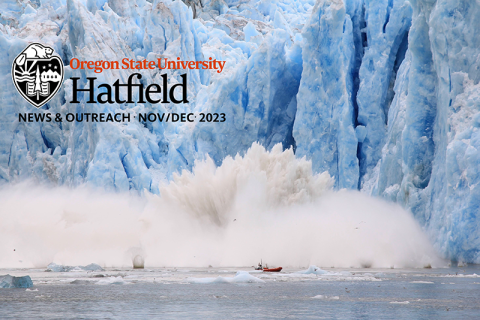
Innovation Lab
The Innovation Lab is a hub for creativity and exploration, a place where ideas can be designed and built.
iLab News
It's Scholarship season
Are you or someone you know interested in interning at the iLab? Applications are now being accepted for the winter term Innovation Lab Scholarship and Internship Fund, which is supported by the Roundhouse Foundation. The fund can support up to three OSU undergraduates, and the total amount of the award per student is $18,640. The winter term application deadline is Dec. 3, 2023. Applications for the spring term open April 1, 2024, and close May 1, 2024. Learn more about these opportunities here.
Researcher & Interns Create Minimally Invasive Monitoring Tech
Research Associate Kyle Newton from the Big Fish Lab worked with the iLab and interns Rylin Duster and Baxter Millsap to develop a holder for a biologger that can be attached to long-nose and big skates. The device, which attaches using surgical glue, pops off the animal within about 24 hours and floats to the surface for retrieval. This project went through a number of prototypes until the final adaptation, which is a small, sleek device that fits the profile of skates. Newton hopes to use this device to determine if skates are affected by magnetic fields produced by offshore energy facilities. This short video, created by summer interns Maia Norton and Baxter Millsap, documents the development of the biologger.
iLab Goes to Alaska

Scientists and their equipment often work in extreme environments. This is the case for the Coastal Boundary Dynamics Research Lab from Oregon State University’s College of Engineering. They reached out to the iLab to develop an automated deployment system for a multibeam sonar that researchers were deploying in ice-saturated waters near an actively calving tidewater glacier.
Read how this project led the iLab team to Alaska and the intern whose summer project was seriously field-tested.
Idea - Prototype - Production
One of the gems of the Gladys Valley Marine Studies Building is the Innovation Lab or iLab. This lab has space and equipment to take your project from the idea phase, to fabricating and testing a prototype and into production.
This vast 2,563-square-foot workshop will be filled with equipment for electromechanical design, CNC and manual machining, welding and fabrication, lathes, 3D design, modeling, printing and laser cutting. There will also be audio and video systems to support innovation in the marine sciences.
In addition, there is an art studio in the MSB. It overlooks the iLab and provides artists and scientists with a collaborative workspace to explore the passion of the marine world.